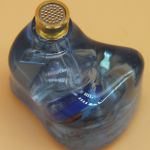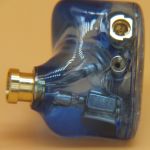
disclaimer: I was provided the Mx3 by Kinboofi (via their Amazon Store) in exchange for reviewing it. I have no financial interest in either Kinboofi or Amazon. arrived 6/22
Unboxing / Accessories:
The Mx3 comes packed in a blue leather(?) box similar to what the older generation will remember as a watch box. The lead edge of the box tilts back and is hinged with a snap-open/closed mechanism to hold the box open. Inside the box is a small square clam shell style case and the warranty card. All other items are hiding inside the clam shell. A foam insert with a cutout for the clam shell would be a welcomed improvement as it would improve the aesthetic of the packaging if little else. Inside the case, we find the cable, earpieces, and 6 sets of tips. The cable and earpieces are individually bagged to prevent scratches and each type of tips is bagged separately. Tips provided are 3 sizes of black silicone star type tips and 3 sizes of spin-fit style tips with green center cores and translucent domes. No explanation of the tips is provided, but my observations were the black are a bit more bass oriented while the clear are a bit more balanced.
Build/Fit:
Ok, so yes these are a looker. Shells are acrylic with what appears to be polished steel wool in the face plates and a medium blue transparent body. The most distinct feature of the Mx3 is the stainless vent immediately in front of the mmcx ports. When illuminated one can trace the tubing from the back of the vent to the rear of the dynamic driver. This means the shell can be poured acrylic and solid rather than hollow as is more common with dynamic driver models and hybrids. Size wise, these are on the larger side and are similar to the Fiio FH5 or Kinera Idun in both shape and overall dimensions. Nozzles centered at the lower end of the shell with no rake to speak of and allow for fairly deep insertion. Isolation is fairly good as a result. Nozzles do have a lip for tip retention as well. MMCX connectors are mounted cleanly with no visible gaps or glue. These appear to be a handmade and polished shell which is quite an accomplishment at the $135 price being asked.
Internals:
The MX3 is a hybrid design using a 10mm dynamic driver paired with 2 BA drivers. The BA drivers consist of a Knowles ED29689 handling the mids and a Belssing 30095 handling the high end. Details about the Dynamic driver are a bit harder to find. The dynamic is set up with a vent immediately in front of the MMCX connector and a sound bore from the front to the nozzles so unlike many which utilize the chamber, the dynamic driver is completely enclosed in this design. Measured impedance was 21Ω with a sensitivity of 116dB\mW (+/- 3db between 200hz-12kHz). I found the Mx3 easy to drive, but better with a bit of extra power as the coherency suffers when not powered adequately.
Cable:
The cable provided with the Mx3 is a 6 line braid below the splitter and a 3 wire braid above. Fixtures are a straight 3.5mm jack with a polished aluminum case, a brushed aluminum splitter, and a clear bead chin slider, followed by brushed aluminum mmcx connectors with pre-formed hooks. MMCx are marked for L/R with the standard red ring on the right side. The cable shows good pliability with little microphonics. I had no issue with the earpieces shifting once in place due to cable pressure so use running or in the gym is quite possible.
Sound:
Bass:
Sub-bass has good rumble and authority. Mid-bass follows with equal thump, but not particularly ahead of the rest of the signature. Attack speed is good with just slightly slower decay that leaves some warmth in its wake. Bass texture is well done and I found little if any tendency to get thick as tracks got more complex. Its a dynamic driver bass doing a good job of mimicking a BA bass. Tight, and clean, but without a lot of sub-bass. I do think it delivers a bit more warmth than a typical BA bass and departs from that comparison in that way.
Mids:
The transition from mid-bass to lower-mids is clean and smooth without notable bleed or obstruction of the lower-mids. Thankfully, there is no dip in the lower-mids as is so common today. They are near linear from the mid-bass and the detail level of the lower mids is quite good. I have to remind myself that this is still arguably a budget model as its mids are competitive with things I’ve paid considerably more for. Texture of the mid-range is better than expected and as such the growl of electric guitars (Lenny Kravitz anyone?) is satisfyingly realistic. Upper-mids push forward and do emphasize the vocal range well with upper range vocals cutting through a bit more than lower counterparts. Bass and baritone vocals are inline with guitars and lower instrumentation while anything tenor and up starts pushing a bit more forward in the mix. The push is well done and isn’t a ball of spikes as some are but more of gentle curve that is difficult to establish the exact boundaries of.
Treble:
While I am beginning to think I could write about the treble of the Belssing 30095 in my sleep due to its popularity, I have to admit this is one of the cleaner implementations I have heard and lacks the grain and big peaks and valleys often associated with it. Lower treble is elevated but not jagged or harsh, there is a drop off above that and then a bump around 9k that brings some air to the top end. Final roll-off becomes perceptible quickly above the 11kHz mark. Overall, a very pleasant treble with enough energy to feel lifelike without getting strident or harsh. Cymbals are reasonably well executed and believable.
Soundstage / Imaging:
Soundstage is a bit wider than deep, and does give some sense of height. I would define the sound stage as smaller theater size rather than cavernous. Instrument separation is quite good and seating the orchestra by listening puts pretty much all in the correct place. Spatial cues are well handled so movement around the stage is very precisely rendered. Layering was quite good as well with complex passages being well rendered. The Mx3 did not have any trouble with more complex tracks and didn’t seem to get dirtier as track complexity scaled upward.
Comparisons:
I have tried to compare to models at roughly the same price point. I am not going to go into build comparisons as all are well made.
ikko OH1 – Both have similar tunings with the major differences being the sub-bass digs deeper on the OH-1, and the Mx3 has a cleaner treble and handles complex tracks a bit better. Those looking for more bass will appreciate the OH1 while those looking for something a bit closer to neutral will like hte Mx3.
Simgot EN700Pro– The 700pro is a good bit more V shaped than the Mx3 and struggles as volume increases. While I like the 700pro at lower volumes, it is hard to compare it here as it simply cannot be driven hard without introducing considerable distortion.
Fiio F9 Pro – Way more V shaped and nowhere need as detailed in the mids, the kit on the Fiio is way better, but the sound on the Mx3 easily distances itself from the F9 Pro.
Kinera Idun – These two are more similar than not. Both have good bass control, but will not satisfy the basshead crowd. To me, the Mx3 is a bit better on lower mids, while the idun is a bit closer to neutral in the upper-mids and lower treble. those who prefer a bit brighter signature will opt for the Mx3 while the treble shy may prefer the Idun.
ToneKing 9-tails – regardless of which filter I used, the 9-tail is more of a V than the Mx3. Bass is a bit heavier hitting on the 9 tail, but speed and texture is a bit better on the Mx3. Mids have more detail on the Mx3 while treble is slightly more detailed on the 9-tail. Fit can be an issue with the 9 tail, while the Mx3 is a bit more of a conventional design.
BGVP DMG – The DMG with its stock filter set digs deeper in the bass than the Mx3 but is not nearly as clean as decay is a bit slower and comes across as a bit loose when compared to the Mx3. Mid detail is good on both, but timbre and texture are a bit more realistic on the Mx3. Treble is a bit more forward on the DMG and both roll-off at roughly the same point.
Thoughts / Conclusion:
The Mx3 is extremely well made especially considering this is a handmade shell at an asking price of less than $150 USD. I am impressed with the venting system utilized and hope it becomes more common as it removes variables associated with materials when the shell is used rather than using a tubed vent like the Mx3. (The Magaosi DQ4 shares a lot of design similarities with the Mx3 and also uses this sound bore vent dynamic driver design.
Sound wise, Kinboofi is obviously coming of age as each successive product has a bit more coherent and mature tuning. I was impressed with the Mk4 and the Mx3 may be a bit better with respect to coherency if not detail where the Mk4 still has the advantage. The Mx3 shows good linearity with a push in the upper-mids/lower treble that brings vocals to the forefront and adds a bit of vibrancy to the mix.
Having recently auditioned the Mk4 and now the Mx3, I now believe that Kinboofi is a highly underrated brand in the mid-fi space. Both of these two models are very cost competitive and deliver excellent sound for the asking prices. Those who are more familiar with the <$40 models are not seeing what Kinboofi is really capable of. Having reviewed a few models in the lower space, they do not do the brand justice and Kinfboofi should really consider splitting the higher-end models into their own sub-brand to differentiate them from the lower end products.



















Post a Comment